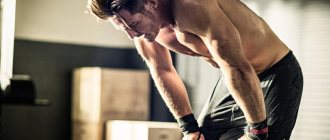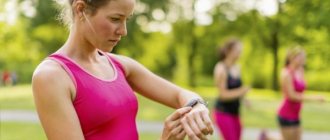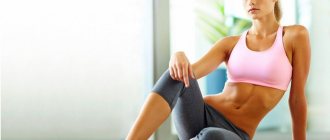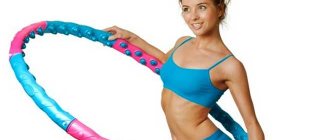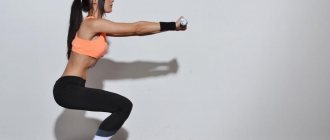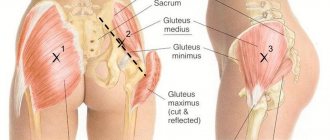What are the benefits of running in place?
Like any cardio exercise, running in place trains the cardiovascular system. Aerobic exercise will trigger the same processes as regular running. And in this sense, running in place is not inferior to running on the street in any way.
Running in place is a solution for those who do not want or cannot go outside; for runners recovering from injury or a long break from training; for beginner athletes.
The technique of running in place is easy to learn and is the same for any runner. It does not require simulators or complex equipment - only a minimum of space and free time.
Benefits of running in place:
- If you ventilate the room before the start of class, the body is saturated with oxygen. Pressure increases, energy consumption processes start, muscles warm up, capillaries expand and work better.
- The immune and nervous systems are strengthened, muscles are strengthened, and posture improves.
- The impact and total load is significantly less than with street running, so running in place can be chosen by those who are interested in gentle training.
- The weather won't ruin your training plans; doesn't need a lot of space; no need for fancy street running gear.
August 16, 2017
91143 views
Evgenia Shagina I believe that we can create a world filled with love and joy by creating ourselves with love and joy. Entrepreneur. Coach. Trainer. Author of the blog shaginaverh.ru, whose motto is to beauty, awareness and life purpose! Lately, I’ve fallen in love with conducting quests, challenges and marathons with myself to get rid of old and unnecessary beliefs and develop the desired habits. This helps me live an interesting life and generate more energy.
- shaginaverh.ru
- facebook.com/evgeniashagina
- vk.com/shaginaevgenia
When I started posting the results of my running morning on social networks, questions started pouring in. What does this mean?
First of all, the fact that most people are visual: they see a picture with numbers on it - the question arises: “What is this?” Yeah! Information caught! And when you just write in status, there is little interest. This means that we are not far from childhood - we would like books with pictures. And that's good. As Jesus said: “Be like children.”
The first question is usually: “Where do you run? On the treadmill? When I say that it’s just from window to window, my interlocutor is perplexed: “How is that?!” Next comes the question/remark: “What kind of running around/bullshit/nonsense is this?” (options are possible). I'll explain. Some people lose interest in the topic, while others, on the contrary, grow.
It’s interesting that many people are more interested not even in running, but in the program on their phone that counts steps. Aw, what a cool thing! For women, it is like another bow, frill, handbag, fondant, shoes... In short, another interesting thing that you can have fun with. At first, I perceived it the same way - complete delight and an enthusiastic squeal every time, to the accompaniment of victorious fanfare, they told me that I had walked 10,000 steps! When I started running every morning, the program turned into a regular working tool, I saw many additional pleasant functions in it.
So, why do I run at home, and not in the gym, not in the park, or, at worst, not on a treadmill?
I answer. I like it when everything is in order, along the way, so as not to waste extra time. Getting dressed, going outside, walking/driving to a public garden or a fitness club (at least an hour on the way there and back) is not for me. It’s easier for me to get up in the morning, drink a glass of water, and immediately, in shorts and a T-shirt, start running.
By the way, about clothes. This is also a moment that puts many people off for a long time from starting running. At first I put on shorts and a T-shirt. Now I really run in a regular tight T-shirt and swimming trunks (sorry to the aesthetes). After all, you can’t go to a fitness club wearing just anything, and you also need to dress decently when going outside. To run outdoors you need clothing for winter, spring/autumn and summer. And at home you don’t need anything at all.
Now about the treadmill. My problem is that I often don't know what I want. When I started running (even walking at first), I didn’t know how long this hobby would captivate me. It could have turned out like this: I would have bought a treadmill and after a couple of weeks I would have covered it, as happened with the exercise bike.
Further. In a sports store, the salesperson would probably ask me a tricky question: “What kind of track do you need? With what functions? And I have no idea! I still don’t know why I need it - all this running around, but here are such serious questions! It could have turned out that after a couple of months I would have stopped running because the track turned out to be wrong. Again disappointment. In general, I think this: you need a track when you already run thoroughly and know exactly why this track is needed.
By the way, the issue of money and space for the path is also relevant. “Cheap and cheerful” - you still have to manage this. And it happens that the money is spent in vain, and it is impossible to walk around the apartment because of the exercise machine, which is almost two meters long. I don’t have a separate gym for it.
About fitness clubs. I think this is for those who like to show themselves and look at others. And who cares about time. Or someone might have a gym club across the street. Not so for me. Therefore, for myself, I have crossed out fitness clubs for now. Plus, in my program, first “Tibetan pearls” for warming up, then running, then Surya Namaskar for stretching and relieving tension in the muscles. And then straight into the shower. It would be difficult to combine this in a fitness club. However, I’m sure that I just haven’t seen fitness clubs yet and haven’t understood why I need them. I have no doubt that this is a cool thing: it’s not for nothing that many people like them.
Running in the fresh air is again a bad luck. When I lived outside the city, we had mud everywhere, so I ran around in the yard. But in the city, the nearest park is half a kilometer from our house, and to get there, you need to cross a very unpleasant busy highway. This doesn't suit me either.
In general, you understand that I have enough reasons for home running. And all are valid 
Why did I start running? Because I discovered that I was out of breath while climbing to the third floor. Plus the example of a friend of mine who takes 1000 steps every morning and at 84 remains in great shape. Plus the example of my dad, who always ran in the hallway on a mat (running in place). Now, however, he walks outside - 5 km every day. But he has a good park nearby and a pension - there is no hurry. And an iron will - he goes for a walk in any weather, at any temperature and any precipitation, I can’t do that yet. And my friend and I once climbed the mountains. She is five years older, and rushed ahead of me like a mountain goat. I somehow kept up with her. She always walks. And I'm in the car all the time. After this hike, I also thought about it. And she started running.
How do I do this?
I wake up, drink a glass of water, do the Tibetan Pearls complex or Surya Namaskar (according to my inner desire - whatever I want). Where can I get this? In the Internet. Is there a video. There are texts.
Then - headphones with dynamic music in your ears and forward from one room to another, from window to window, back and forth. Do you remember when we had a shuttle run at school?
My phone has a pedometer program called S Health, which counts the number of steps I have taken. There you can set time, speed, and set different training goals. There are many similar programs for both Android and iOS.
In our apartment, the rooms are located opposite each other - this is my distance. In one room I open the window, it’s cool in there (especially when it’s minus 34 outside). It turns out an additional element of hardening: from heat to cold, from cold to heat.
At first I ran for 20 minutes. Then I started adding 3-5 minutes. Now I have increased my jogging time to 40 minutes. The most difficult thing is to endure these first 20 minutes: in the interval between 17 and 20 minutes you really want to give up everything, and then you get a second wind.
At first my ankles were very tired. I’m running around in the apartment, with neighbors underneath me. Therefore, my running is easy, on my toes. The ankles are very springy. But it's good for the spine. Warming up before running (Pearls or Surya) helps the ankles.
The same movement gets boring, so I amuse myself by tensing, retracting and releasing my abdominal muscles while running, and observing the sensations. Either I run with my arms raised up, or I turn my feet in or out, or I raise my knees high. Or, when the music is right, I just dance. I'm at home, no one sees me. The main thing is to listen to what the body wants and do it. And the pedometer, you know, counts your steps.
I set a goal - to take 100 more steps every day. I'm trying to improve the time result.
Many people ask about time. Like, it takes too much time. Agree. In the morning, together with all the Pearls, Suryas and souls, I devote two hours to myself. Of course, you can spend them on work or other “useful things”. Don't know. I like to dedicate this time to myself. I'm just blown away by the fact that this is MY TIME. And that I don’t just waste it, I invest my time in myself. By myself. It's great when I take care of my body myself. Isn't this self-love?
I get up at 6:00. If you need to wake up your son early, then at 5.45. I go to bed at 22:00. I'm getting enough sleep. If someone can’t sleep in the evening, try getting up at five in the morning, I guarantee that in the evening they’ll pass out, regardless of the importance of things 
People ask: when is it better to run - in the morning or in the evening? I like it better in the morning. If I don’t run in the morning, then in the evening, even if I have time, I don’t feel like it. But this is my option. Perhaps the evening is more suitable for some.
After running, take a shower. The T-shirt is in the wash.
After I started running every day, I rate my condition as “in good shape.” I go up to the sixth floor without any problems. There is a desire to live and enjoy life. After running, the first half of the day is especially productive. When the day is scheduled minute by minute and I get everything done, I feel a feeling of “deep satisfaction” and pride. In the evening there is something to thank the day and yourself for. And I thank you with all my heart!
They say that you still need to go to classes to develop other muscle groups. Surely it is necessary. As soon as I’m ready, I’ll go. In the meantime, I’m training at home, running from window to window. After all, it doesn’t matter which way you choose to love yourself.
Healthy lifestyle #Running #Motivation #Apps
What muscles work when running in place?
The same muscles work as during normal running - the muscles of the legs and core.
- The thigh muscles are on the back of the legs. These muscles are responsible for bending the knee.
- Quadriceps. They are located on the front side of the thigh, are activated when the leg is extended, and play a large role in the correct movement of the hip and knee joints.
- Gluteal muscles. It is thanks to them that the body is in an upright position.
- Calf muscles. Stabilizing muscles are responsible for balance and lifting the leg while running.
- Iliacus muscles. This is an internal group of pelvic muscles; they regulate the flexion of the lower leg.
- Intercostal muscles. They work when you inhale and exhale.
- Abdominal muscles. They turn on when you lift your leg as it moves forward.
Disadvantages of running in place
- Still, the load is lower compared to street running. No change in terrain, no opportunity to accelerate, no oncoming air resistance.
- Monotonously. Escape with music, a movie, a podcast, an audiobook.
- Does not provide weekly running volumes - only heart training.
- If the technique is incorrect, running in place can cause harm.
source: verywellfit.com
Special running exercises: what are they and how to do them?
SBU (special running exercises) will help improve your running, develop endurance and strengthen your joints and ligaments. Nike running club coach Olga Smirnova tells which SBUs should be done, and our Christina demonstrates how.
Why do you need special running exercises? “The SBU prepares ligaments and joints for running,” says Olga Smirnova. “These exercises are excellent for developing strength, endurance, and coordination of the leg muscles, especially those that bear the main load when running. SBUs increase the frequency of steps when running, the repulsion force of each step and improve running technique. Athletes who regularly perform SBU spend less effort over distances and significantly improve their results.”
Jumping from foot to foot and the same jumping with circular movements of the arms
The exercise prepares the foot for running, increases the force of its repulsion from the surface and improves coordination.
In the first option: the upper shoulder girdle is not tightened, the arms are relaxed, working in opposition to the legs. We jump on one leg, then on the other.
In the second option: do everything the same, but add manual work. In addition to working the leg muscles, we develop the shoulder joint and back muscles.
Running sideways with side steps
We put our leg to the side and when we transfer the body weight to it, we jump, placing the other leg.
With lateral pushing, even more foot muscles work. Without landing on our heels, we more actively charge the foot, working the gastrocnemius and soleus muscles.
Hands work towards and away from you, one jump - one change of hands.
Running with shin splints
When running, we try to reach the butt with the heel of our foot (we do an overlap).
This exercise works the foot and calf and hamstring muscles, namely the hip flexors.
Perform the exercise quickly and land on the front of your foot. The torso, as in running, is slightly tilted forward, the arms are mobile.
Running with high hips
When jumping, we try to raise each leg until the thigh is parallel to the floor.
The exercise is as close to running as possible, allowing you to feel the landing of your foot. Develops the muscles of the anterior thigh and calf muscles.
The arms work as if they were running. Do not lean your body back, your back is straight, your foot is contracted towards you. Execute quickly and land on the front of your foot.
Running on straight legs (“wheel”)
The exercise is useful for further strengthening the foot.
Land on an elastic foot, never on a relaxed one. The arms work as if running, keeping the body straight. The height of raising the legs depends on the task: the higher we raise the leg, the more the push-off is practiced and the iliopsoas muscle is activated - the lower we place it, the more emphasis is placed on the foot and landing.
Running backwards
Practices bending the shin when running and pushing the foot off the surface.
Tilt your body slightly forward, and throw your legs back as far as possible through bending. The arms work as if they were running.
Walking on toes with straight leg raise (“tin soldier”)
We work the calf muscles. Literally after 15-20 meters you will feel how tense your lower leg muscles are. When raising the hip, the lower abs and iliopsoas muscles are activated. When we raise our legs, the gluteal muscles are in a stretched state, when we lower them they are in a contracted state. This allows them to be further processed.
The back is straight, the hands touch the toe of the opposite leg, the foot is contracted towards itself.
"Bike"
The exercise is similar to the hip raise, but here the legs move in a full circle with a slight forward thrust. The same muscles work as with the “high hip”, but the emphasis is on maximum flexion. The arms move back and forth, just like running.
A common mistake is tilting your back back. As soon as the back goes back, the lumbar region becomes tense.
Land on the middle of your feet. The more often we increase the force of repulsion from the surface, the faster we become more resilient and stronger in running.
"Mill"
Exercise for coordination and balance. The “mill” involves the back, especially the lumbar region, as well as the gastrocnemius and soleus muscles.
Take side steps with your legs in an inclined position, kicking one leg with the other and jumping to move. Hands work alternately, one jump - one swing of arms. We place our legs in the middle of our feet to further work them out.
Multi-leaps (“deer running”)
The most difficult exercise for amateur runners.
It is important that both feet push off the ground. The front leg is bent towards the stomach (the iliopsoas and lower abs work), the angle at the knee is 90 degrees, the back leg is straight. The arms work as in running, but a little wider and further from the body.
Try to jump as far as possible each time. Imagine that you are jumping over a large hole. Maintain coordination and balance throughout your entire body.
“Deer running” is divided into two types: the first is running based on pushing up using the foot. Such multi-jumps are suitable for those who need pushing force from the surface (high jump, basketball, volleyball); the second is running, based on pushing forward, again due to the strength of the foot (for runners and sprinters).
Photo: Dmitry Pospelov, pospeloff.com.
Technique of running in place
If you look into it, running in place can be a great way to hone your running technique in general. A number of rules will protect the runner from injuries both when running on the spot and in the future when running on the street.
Subscribe to “Marathon Man” on Telegram. Announcements of articles and useful selections every week.
- The back must be kept straight and level; bend your arms at the elbows, without lifting or relaxing them too much; the shoulders do not tense; arms move along the body back and forth at waist level.
- The legs must be moved one by one in place, avoiding overlap. The foot lands in the middle, even closer to the toe, exactly under the center of gravity. That is, the runner remains exactly in the same place where he started the workout, without moving forward or bouncing.
- For the first training, you can use a wall - rest your hands on it and move your feet. Such a life hack physically will not allow you to move forward.
- Don’t lower your head, don’t look at your feet – your gaze is directed in front of you.
- Breathing when running in place should be even and calm. The advantage of running in place is that due to the relatively low load, breathing is not interrupted. You can follow a 3-3 rhythm: inhale for three steps, exhale for the next three steps.
- Don't forget to do a general joint warm-up before training and stretching after it.
Breathing while running
When asked whether running in place is beneficial or harmful, it is important to consider the load and technique, because they greatly affect the runner’s breathing.
Breathing technique when running: rhythmic breathing, inhale through the nose, exhale through the mouth. The exhalation should be 2 times longer than the inhalation. However, during training on the spot, you do not bother with the pace, beat, running speed and do not try to adjust your breathing to these parameters. Therefore, when jogging in place, it is easier to breathe steadily. To maintain the heart rate zone limits, parameters must be measured regularly during training.
When practicing in a room, it is important to regularly ventilate the room to saturate the body with oxygen. If necessary, you can move the training to a loggia or balcony.
Running clothes and shoes in place
It's simple - running sneakers, a T-shirt or T-shirt (men can do without them at all, women can wear a supportive sports bra), shorts, bike shorts or leggings. Train in something that is comfortable and not too hot in the room.
And you can choose sneakers without strong cushioning. It is not needed and will eliminate the temptation to land on your heel. Shoes should fit firmly on the foot, not squeeze or dangle. It’s the same with clothes – you can’t let them rub and interfere with your movements.
It is useful to place a regular training mat under your feet. It (along with sneakers) absorbs impacts of the foot on the floor and prevents the feet from slipping. But the mat itself needs to be non-slip.
Shoes and clothing
A big plus in choosing equipment for running on the spot, and even at home, is that you can wear what you feel comfortable in and you don’t have to think about how you look. Even if it is an unsportsmanlike T-shirt or short shorts, in which it would be embarrassing to appear in the gym, the main thing is that the clothes do not hinder movement and the skin in them breathes easily.
High-quality shoes are needed, with shock absorption on the heels and ankle protection. Sneakers should fit securely on your feet without squeezing your foot. Tight models contribute to the formation of edema and can lead to injury.
When choosing sneakers in sports stores, ask the consultant to suggest running sneakers and always with cushioning for your feet
Is it possible to lose weight by running in place?
Can. You need to maintain a balance between calorie intake and expenditure: this is how you can lose a couple of kilograms within a few weeks of regular running in place.
In order to achieve your goal faster, monitor your pulse - it should be low, then the same processes will occur in the body as with any aerobic exercise: the body uses up glycogen, the processes of aerobic glycolysis are launched, in which fat becomes the source of energy.
Heart and lung training and weight loss goals revolve around one heart rate indicator. This is approximately 60% of the maximum impact rate. Working out for 40 minutes at this heart rate will benefit your heart and help you lose weight over time.
Time for a home run
On strength training days, you can run in place for weight loss at home for 20-30 minutes.
This can replace morning exercises. On other days, you can use interval running in place. How many calories you burn depends on how you act. First, do a warm-up (regular walking), then alternate 2 minutes of fast running, 1 minute of jumping, and 2 minutes of recovery slow running in place. The latter can be replaced with a hula hoop or working on a health disk. Effective weight loss will be active provided that you devote about 200 minutes a week to cardio training.
How many calories does running in place burn?
You can burn about 100 kcal in 20 minutes of work. Therefore, for a workout of 30-40 minutes, it is realistic to spend 300-400 kcal. And this is exactly how much you need to train if you want to train the cardiac and respiratory systems.
Calorie expenditure will increase the intensity of your workout. Add running with high knee lifts or shin wraps. It is better to alternate 20 seconds of exercise and 3 minutes of regular running in place. Again, you need to stay in one place and prevent the center of gravity from shifting. These two exercises have a positive effect on honing your running technique and add variety to your monotonous workout.
Read on topic: How many calories are burned when running?
Pour something slippery on the floor
- Pros: It will be fun and slippery.
- Cons: then you have to wash the floors.
A video with instructions on how to make a homemade treadmill has exploded on social media. It's simple: pour a little dishwashing liquid or shower gel onto the tiles. Splash a couple of drops of water. Start walking barefoot - you are gorgeous. Hold onto the edge of the tabletop to avoid falling and be careful. Before starting your workout, make sure there are no crumbs or small parts on the floor. And most importantly: do not forget to clean up after yourself so that other household members do not slip.
How long to run
You need to arrange workouts lasting 30-40 minutes (or better, more) and repeat them 3 times a week. Results in losing weight with proper nutrition will be noticeable within a few weeks.
We do the same for training to develop endurance. The author of the book “From 800 meters to the marathon,” Jack Daniels, advises doing any cardio workout for at least 30 minutes to achieve results.
But it is important to increase the duration of your workout and do it gradually. There is no need to immediately start with a half-hour workout. If you absolutely want to run 40 minutes a day, break your workout into 20 minutes twice a day.
Monitoring your heart rate while running in place
The rules for tracking your heart rate for running in place are exactly the same as for any other type of running. Pulse remains the only indicator for monitoring the correctness of the chosen load.
Read on the topic: Pulse zones: what heart rate to run at
Determining heart rate zones begins with calculating your maximum heart rate. Calculated using the Roberges-Landwehr formula, based on the runner’s age: HRmax=205.8–(0.685*age). But the maximum heart rate may differ for athletes of different levels of training, and the most accurate results will be obtained by a treadmill test using special equipment.
Heart rate during exercise
Pulse and its frequency are an important component in any cardio training, and even more so when running. Monitoring your heart rate allows you to regulate the load during training, accelerate steadily and reduce speed in time.
It is easy to calculate the maximum heart rate (HR) using the general formula: 220 minus - your age.
For example, 220-28=192 is the maximum heart rate for a 28-year-old girl.
- You begin to lose weight when your heart rate reaches 60%-70% of the maximum frequency. Again, for a 28-year-old girl, comfortable fat burning will begin in the heart rate zone of 120-140 .
- The heart rate limit zone is 90%-100% of the maximum heart rate. In this zone you can work through explosive jerks, but only for trained athletes.
To find out your maximum heart rate during training, you can run with a wristwatch that has a heart rate detection function and thus track your heart rate zones.
Knowing your heart rate zones will help you determine which heart rate zones you should run in to lose weight and still feel comfortable.
Summary
Jogging in place is a great alternative for those who don't want or can't leave the house for a regular run. It allows you to stay in shape, additionally load your heart and muscles, and even lose a little weight.
It is important to follow the exercise technique so as not to harm yourself, and in the future, to hone your running movements. Running in place for 30-40 minutes 2-3 times a week will bring results, observing your heart rate zones. Do not forget to warm up and cool down and do not start training if there are contraindications.
Elena Matveeva
Memo
- Running in place improves metabolic processes, promotes cell renewal, and helps launch rejuvenation processes in the body.
- The average duration of weight loss workouts is 20-40 minutes. The first results will appear in 2-3 weeks.
- Start running in place as gradually as you would any other activity. Don't forget to stretch and warm up before and after your race.
- Correct running technique and body position can reduce tension in the spine and lower back and save energy costs.
- Knowing your heart rate zones will help you determine which heart rate zones you should run in to lose weight and still feel comfortable.
- When practicing in a room, it is important to regularly ventilate the room to saturate the body with oxygen. If necessary, you can move the training to a loggia or balcony.
- It is best to get tested and consult a doctor before training.
Do not neglect warming up and cooling down before and after a run, this will protect you from injuries and sprains. Do you want to know how to get your body in perfect shape and lose excess weight? We will send you simple and useful tips absolutely free of charge.
Enter your email and click the download button ↓

